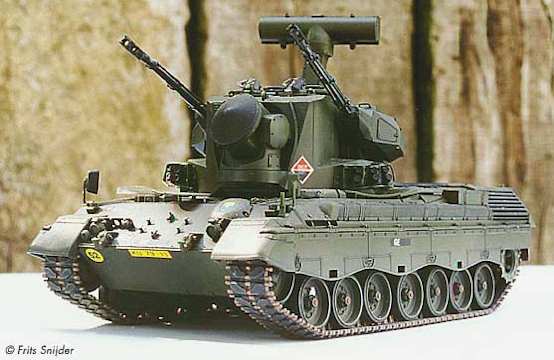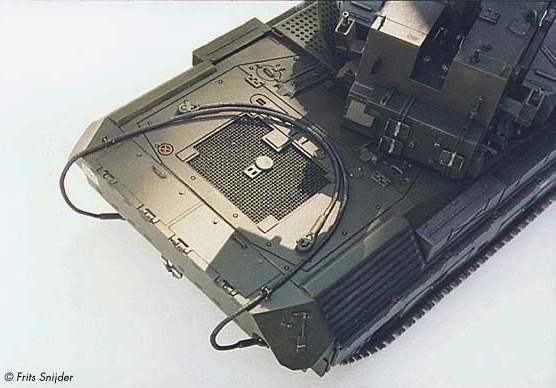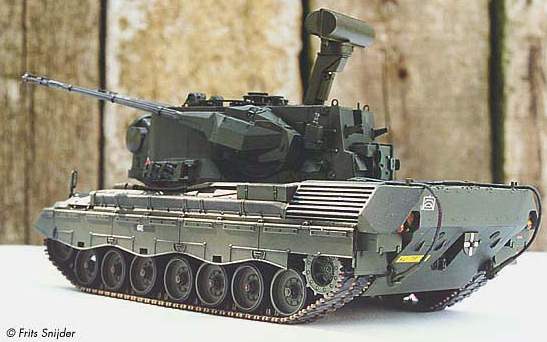The Dutch Gepard in the Royal Netherlands Army
by Erik Keizer
photos by Frits Snijder
This article was first published in ‘Modelbouw in Plastic’ – a magazine of IPMS Netherlands .
Used with permission of the Editor
The PRTL, short for Pantser Rups Tegen Luchtdoelen (Armoured Tracked Fighting Vehicle Against Air Targets) is the Dutch version of the Flakpanzer Gepard. The Gepard was developed in Germany as an Anti Aircraft AFV, based on the Leopard-1 tank. Since 1971 the PRTL forms the backbone of AA brigades of the Koninklijke Landmacht, the Royal Netherlands Army.
Front side of the PRTL model with a nice view at the tracking and surveillance radars and the cannon in combat ready position. The conversion involved mudguards, side skirts, the radars and the many details of the front plate and turret. The most difficult task was scratchbuilding the special type smoke dischargers, seen here below the turret.
History
In 1965 the German army issued a specification for an armoured, radar-guided system with 30 or 35-mm guns, that could operate under all weather conditions. Out of two proposals the Gepard vehicle was chosen, featuring 35-mm Oerlikon guns and turret, Contraves computer system, Siemens tracking radar and a Kraus-Maffei hull. Five prototypes were built. The fifth one was completed with a Hollandse Signaal Apparaten radar system, specifically built for the Royal Netherlands Army.
In 1973 the German army ordered a pre-series of twelve Gepards, followed by an order for 420 additional units. These were delivered between 1976 and 1980. Also the Belgium army ordered 55 Gepards. These were delivered between 1977 and 1980.
After evaluating the initial prototype, the Dutch army ordered a pre-series of five vehicles, which were built on an improved Leopard 1 chassis. In 1973 an order was issued for additional 95 units with the designation PRTL. All were delivered between 1977 and 1979.
From Leopard-1 to Gepard
The initial plan was to base the Gepards and PRTLs as closely as possible on the Leopard-1 tank chassis. Nevertheless, some adjustments had to be made. First the rear of the hull had to be extended to provide room for extra batteries. These could be accessed through hatches on the rear deck.
The rear deck with additional towing cables (lacking on the original kit), made out of twisted elastic bands.
Also the chassis of the Leopard-1 was extended by eight centimetres, which on full-size machines is clearly indicated by the extra room between the third and fourth wheel. The wheels further received new shock absorbers, providing better stability when firing.
The vehicle also received an auxiliary engine which powers the electric generator. This engine is accessible through a hatch on the front deck.
Other changes incorporated new front armour, five extra equipment boxes and a protective hood for the driver.
From Gepard to PRTL
The main differences between German Gepard and the Dutch PRTL are the surveillance radar, the rear turret, the search radar on the front side and the smoke launchers on the turret’s lower edge.
The Gepard has a disk shaped radar, which stands vertically on the rear turret when in use. When not in use, the radar lies behind the turret. The radar equipment is accessible through moveable backside of the turret. The PRTL on the other hand has a rod shaped search radar on a movable arm. When not in use, it rests between the extensions of the rear turret.
The tracking radar antenna of the Gepard has a semi-circular shape, while the PRTL has a conical one. The Gepard has no skirts, while the PRTL does and the Gepard has only four smoke launchers on both sides of the turret, while the PRTL has six on each side.
In service with the Koninklijke Landmacht
The puropse of the PRTL in service with the Koninklijke Landmacht is to protect the units on the battlefield against low flying (up to 1500 m) aircraft and helicopters. For this task the PRTLs are supplemented with Stinger units – personnel anti-aircraft missiles that can be fired from the shoulder.
Of the 95 units in service with Dutch army, fourteen were used for training purposes. The rest has been divided among nine armoured anti aircraft artillery batteries (called PALUABT, short for Pantser Luchtdoel Artillerie Batterij). Of these nine batteries some were kept operational, while other could be activated in case of a conflict.
After the reorganisations of 1984 and 1995-96, three operational batteries remain, 11th and 13th PALUABT, each with four platoons of three PRTLs, and 42nd PALUABT with only three platoons. The 11th PALUABT is part of the 41st Light Brigade of the Koninklijke Landmacht, 13th PALUABT is part of the 13th Mechanised Brigade, while 42nd PALUABT is part of the 1st Division. The 1st Division has mainly a co-ordinating task behind the front line.
Currently 57 PRTLs are still in active service with the Dutch Army. The remaining units are kept in reserve, are being updated or put for sale.
Technical data
- The PRTL is a self-propelled, radar guided anti aircraft gun, based on the Leopard 1 main battle tank. The turret can be moved 360° and has a 35 mm Oerlikon canon (550 rounds/min.) on both sides of the turret, with a range of 3,850 m.
- Gun elevation: -10° to +85°
- Search radar: rod shaped Hollandse Signaal Apparaten radar with a range of 15 km
- Tracking radar: cone shaped Siemens radar
- Engine: 10 cylinder, 37.4 litres MTU diesel engine of 830 hp (610 kW)
- Max. speed: 65 km/h
- Crew: 3
Update
In 1985 the Dutch army started a programme to update the PRTL. This update included modifications to the radar and firing systems, new ammunition and improvements to the air-conditioning and communication systems. Further the storage room for the crew has been enlarged. The vihicles also received a new camouflage.
With these modifications the PRTL will remain in service with the Royal Netherlands Army until 2015.
The Model
Building the PRTL of the Royal Netherlands Army in 1/35th scale is best based on the Tamiya Gepard kit (kit no. 35099). Apparently this is an older Tamiya offering, and the quality is not as high as would be expected these days. Overall detail is sparse and no interior is present. Furthermore the kit depicts one of the pre-series Gepards and not one of the standard production models.
In order to build the PRTL, I had to first upgrade the kit to a standard Gepard configuration. Here’s a checklist of my modifications.
- The most obvious difference between the pre-series Gepards and the standard production model are the front mudguards. I borrowed mine from the Tamiya kit of the Leopard-1A4.
- Both tow hooks on the front plate had to be placed straight instead of at an angle.
- I left off the long box on the front plate and filed down the top of the air intake to a rounded shape.
- Along the left side of the chassis, the exhaust pipe of the auxiliary engine should run from the front to the rear and end in the left exhaust of the main engine.
- The exhaust of the auxiliary engine is covered with grills. On the pre-series these were attached with bolts through two large plates. The production model omitted these plates and all grills were attached individually. I remove the big bolts and replaced them with smaller ones on each grill.
- On the right side of the chassis of production Gepards four boxes are placed, but the last one, in front of the exhaust of the main engine, was missing in the kit. I carved the missing box from plastic sheet.
- All track wheels in the kit are fitted on the same distance. In reality the distance between the third and the fourth wheel was some 80mm longer. I removed the wheel axles of the last four wheels on each side and repositioned them 2.3 mm to the rear.
- On the turret the glass between the two periscopes should be covered with a small hood. I added on from a piece of plastic sheet.
- The hoists on top of the turret had to be repositioned at a 45° angle.
Now let’s take the project from Gepard to PRTL! The most obvious differences between the Gepard and the PRTL are the search radar on the rear turret and the tracking radar on the front. Further the smoke launchers are different, as well as some other details.
- The search radar and the modifications to the rear turret were made from plastic strip, sheet and tube.
- I modified the tracking radar of the kit to a PRTL radar by adding a copious amount of putty and sanding it to proper shape with a motor tool. The PRTL also has metal bars to the left and right of the tracking radar, which protect the mechanism when the radar is not in use. I fashioned these from strip plastic.
- The most difficult addition to the model was smoke launcher installation. All launchers are canted 15°, with the two front launchers firing forward, the middle two 15° forward and the last two 30° sideways.
Additional detailing
The detailing on the Tamiya kit was very sparse. I replaced all grips with pieced copper wire bent to shape. While being at it, all the hinges were replaced with stretched sprue. The two towing cables with attachment points were added to the rear deck.
Several toolboxes have reinforcement ribs. These were added from strip plastic.
The PRTL has several anti-slip walkways. I smiulated these by masking off the appropriate areas, spraying gloss paint to them and sprinkling fine sand onto the surface.
Both periscopes and the ejection mechanism of the guns required some extra detailing. Plastic strip and stretched sprue were put to good use here.
The Tamiya kit has virtually no interior. I have detailed both the driver compartment and the turret in my model.
Looking downwards into the scratch-built interior of the turret and the driver’s position. At the command centre the radar screen, joysticks and periscopes are nicely detailed. The eject mechanisms for cartridge links, on top of the canons, are also among the extras.
Painting and weathering
The base colour of the PRTL i it’s original guise was is Olive Green RAL 6014 (approximate FS color being 34087/24064). I used Tamiya XF62 acrylic for the chassis, with 10% black added for the turret. This because the original turret had a slightly different colour, as it came from a different factory.
After the base coat was dry, the model was sprayed with clear gloss varnish (Tamiya X22) prior to decaling. Afterwards the decals wwere sealed with a mix of clear gloss (X22) and Flat Base (X21).
The gun barrels were painted with a mixture of Humbrol 33 Matt Black, 85 Satin Black and Metalcote Polished Steel in proportions of 4:4:5.
The PRTLs of the Koninklijke Landmacht are well maintained and kept clean – especially during the period when there were still conscripts in the Army, who would otherwise be bored to death… Weathering was therefore kept to a minimum. Only the protruding parts were dry brushed with a lighter shade of olive green. Wheels and chassis were lightly sprayed with Pactra Weathering (A53).
Left hand rear side of the PRTL model. The extra space between the third and the fourth idler wheels, the result of stretching the chassis, is obvious.
The model depicts reg.no. KN-79-13, of the 41st PALUABT, stationed in Germany in 1994. All PRTLs stationed in Holland had numbers starting with KN-80-.
Most markings come from the decal sheet from IPMS Netherlands Voertuigen van de Koninklijke Landmacht. Unfortunately this sheet is now out of production and difficult to obtain.
I used plastic sheet for the number plates. Letters and numerals were taken from Mecanorma PF65.8CLN 2mm dry transfer sheet. With some minor modifications the bridge classification sticker (yellow circle, black ‘52’) decal was used, as well as PALUA symbol (white square with symbols, on the rear and front). Other markings were either dry transfers or hand painted.
Note that the updated PRTLs are now camouflaged in the standard NATO scheme of RAL, which is Bronze Green RAL 6031 (FS:34094), Leather Brown RAL 8027 (FS: 30051) and Black RAL 9021 (FS: 37038). Check with your references for actual camouflage pattern.
In 1994 Erik Keizer was one of the last conscripts of the Dutch 41st PALUABT to work on the 35 mm guns of the PRTL at Bergen-Hohne in Germany. The 41st PALUABT was part of the 41st Armoured Brigade, stationed in Germany.
As the Dutch sector of the complex would be closed, and the 41st PALUABT disbanded, the number of operational PRTLs had already been reduced to three. This gave him ample time to photograph, measure and make drawings of the PRTLs. It paid off, as Erik won the first prize in the category Military Vehicles of the Dutch Nationals in 1996 with his 1/35th scale PRTL.
This article was originally published in IPMS Stockholm Magazine in June 2000.



